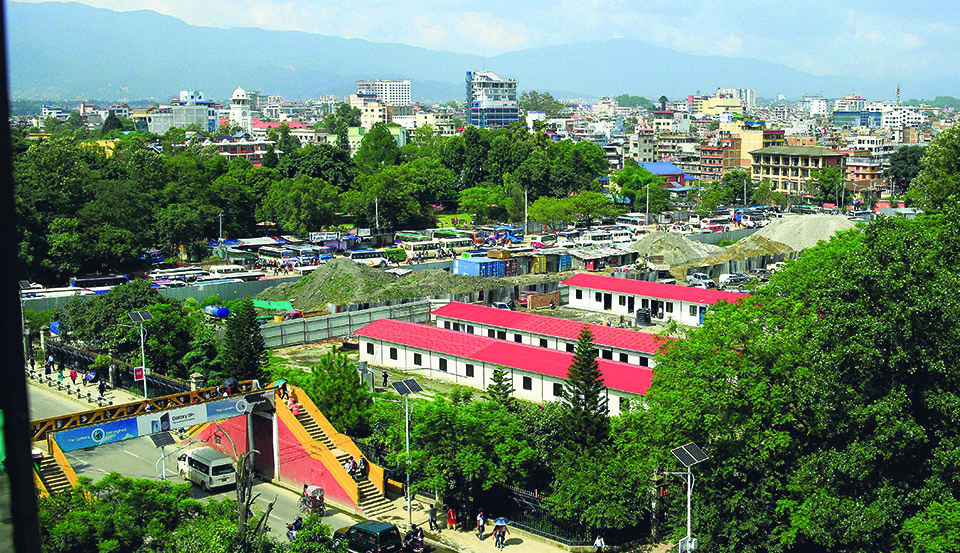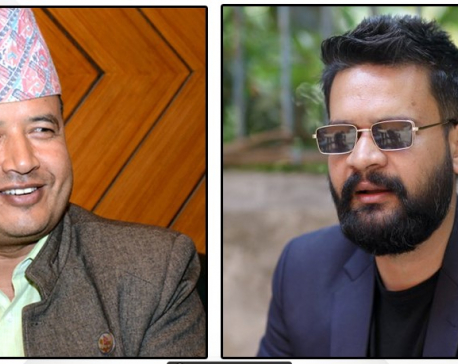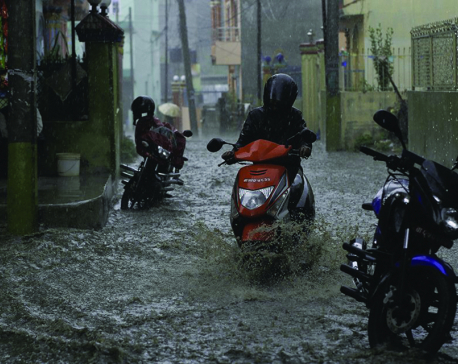
OR

As open spaces continue to shrink and big houses are blossoming around, there is less chance of surviving if an earthquake of a big magnitude hits Kathmandu again
News reports, one after another, continue to reveal how rulers (of different times), politicians and land mafias have encroached on the public and government lands in Kathmandu Valley: “Big businesses involved in Lalita Niwas land scam” (Republica, April 18), “Where is Pashupatinath’s land?” (Annapurna Post, May 14), “Retired land revenue officer accused of grabbing 590 ropani government land” (May 18) to note a few. There might be several cases of land grabbing and consuming for personal benefits in the name of Guthis, councils and organizations all across the country. Political interference and vested interest of particular group seem to have nurtured the grabbing game. Properties of national value and pride have suffered the most. What’s more, the government has now set its eyes on Budhanilkantha School, a public boarding school which is known for academic excellence. The Municipality Mayor said the government was willing to ‘utilize’ the school land by building a bus park.
Grabbing game
The recent follow-up reports on Lalita Niwas land scam by Republica revealed how land mafias have succeeded in influencing several chief land revenue officers, ministers, political leaders and other government officers so as to illegally transfer ownership of land before selling to half-a-dozen business houses. The controversial land purchase deal is under investigation now. From illegal settlements in the river banks to encroachment of the commons on the pretext of setting up a temporary facility, grabbing of public land is ubiquitous and rampant.
The story of Khula Manch or ‘open theatre’, a public open space situated in the heart of Kathmandu, is no different as the place has been continuously encroached upon for years. It was one of the largest public open spaces of the city with 48 ropanis (24,406 square meters) land. Today, Khula Manch is no more Khula (open) as it is being used as a bus park and construction materials store for Bir Hospital and Durbar High School. Last month, 52 unauthorized shutter rooms at Khula Manch were demolished after they were found to be constructed by an individual for business purpose. The Municipality and concerned authority only took the action after activists staged demonstration and the public outcry mounted. Why can’t government be extra vigilant and act quickly enough to protect open spaces?
If not encroached or grabbed, the public and historical properties and monuments are ruined in terms of their physical appearance, historical values and have become less accessible for the public. The reconstruction of Rani Pokhari is still in limbo following the dispute among National Reconstruction Authority, Department of Archaeology and Kathmandu Metropolitan City over construction model. The use of concrete in ancient temples including that of Vishwarup temple on the premises of the Pashupatinath temple and construction of concrete path at Pashupatinath area are few testimonies of government’s recklessness toward national pride projects. The construction of Kathmandu view tower is delayed too. The Kathmandu Metropolis extended the contract by one year in April. This means the bus park will remain in the Khula Manch until the construction project is completed.
No way out
Central Nepal is still being rocked by aftershocks of 2015 earthquakes. There have been couples of strong tremors recorded in the last one month only. These aftershocks, especially the strong ones, remind us of terror and devastation we faced four years ago and also serve as a warning of lessons unlearned. We all seem to have already forgotten the terrified look of earthquakes and have moved forward as if nothing had happened. The open space that sheltered us during the 2015 earthquake in our area is no more there. Building regulations and planning bye-laws are being overlooked and violated at the time of construction of houses and buildings. Houses and building are still being constructed according to one’s needs and budgets and nobody seems to be complying with rules and regulations. As open spaces continue to shrink and big houses, mostly four-story, are blossoming around us, there is less chance of surviving if an earthquake of a big magnitude hits the Valley anytime soon.
Owing to rapid urbanization, incessant fragmentation of private land and encroachment on public land, open spaces in urban areas, especially in Kathmandu Valley, are fast shrinking. Agricultural lands are gradually disappearing as haphazard development including that of big projects such as apartment housing flourish. Today, it is hard to find a potato or paddy field inside the Ring Road. Our city is deprived of public parks and playgrounds, which are supposed to be the integral part of modern cities.
World Health Organization (WHO) recommends a minimum availability of nine meters per person of green open space for the city dwellers. However, according to the periodic plan of municipalities, the availability is only 0.25 meter and 4.34 meters per person in Kathmandu and Dharan respectively. The issues related to open spaces in urban areas have remained ignored in policy making and urban development practice in Nepal. Cities and municipalities across the country lack basic infrastructures and facilities.
Need of open space
Open spaces and parks in urban areas provide breathing space for the public and help to improve physical, social and psychological wellbeing of people. In case of disasters, particularly earthquakes, open spaces can be used for evacuation and temporary settlements. Public open spaces including spacious footpaths and streets are also regarded as the drivers of urban prosperity and are, no doubt, the amenities of urban areas.
Equitable access to open spaces is also related to democracy and freedom. Public spaces cater multiple functions and can also provide spaces for public gatherings and social interactions. Over the decades, public spaces powered democracy in many countries around world as these spaces such as chowks, squares and streets have been used to demonstrate and protest. The democratic uprisings in the Middle East countries are noteworthy where people staged at public squares and avenues which were under the control of the dictators for a long time.
In Nepal too, public places such as Khula Manch, Tundikhel and Maitighar Mandala played crucial role in ushering democracy in 1990 and during the 2006 revolution. Public places have greater use beyond protests and revolutions. Local commons can be used for celebrations, festival, art events and so on. The grabbing game is not only about shrinking of open spaces but also about how power-mongers could actually seize people’s freedom by not letting people breathe, play and gather in the open.
Leave alone planning and construction of new parks, government is doing very little to maintain existing public parks in the valley as most of the parks are in a dire condition and wear deserted look due to lack of infrastructures, poor maintenance and road expansion projects. Goal 11 of Sustainable Development Goals (SDGs) emphasizes on making our cities sustainable by creating safe environment for all. It involves investment in public transport, creating green public spaces and improving urban planning. The government should formulate plans to preserve, maintain and create open spaces which are critical to the well-being of urban communities. In order to develop sustainable cities, the government should start promoting and planning open space concept and stop the land grabbing game of mafias.
sandip.neupane24@gmail.com
You May Like This

UML leader Basnet to Balen: Don't be pampered just because you have a few hundred fans on Facebook
KATHMANDU, August 26: While the Mayor of Kathmandu Metropolitan City (KMC), Balendra Shah, is speeding up the work to demolish... Read More...

UPDATE: 4.6 magnitude tremor jolts valley
KATHMANDU, July 6: A tremor was felt in Kathmandu valley and its surrounding areas at around 4.15 pm on Saturday. Read More...

Saving Kathmandu
The houses and structures which have blocked rajkulos and canals should be shifted elsewhere ... Read More...






Just In
- Challenges Confronting the New Coalition
- NRB introduces cautiously flexible measures to address ongoing slowdown in various economic sectors
- Forced Covid-19 cremations: is it too late for redemption?
- NRB to provide collateral-free loans to foreign employment seekers
- NEB to publish Grade 12 results next week
- Body handover begins; Relatives remain dissatisfied with insurance, compensation amount
- NC defers its plan to join Koshi govt
- NRB to review microfinance loan interest rate












Leave A Comment